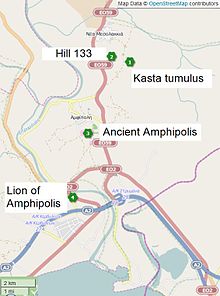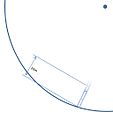Kasta Tomb
Τύμβος Καστά[1] | |
 3D representation of the tomb structure | |
 Location within Greece | |
| Alternative name | Amphipolis Tomb (Τάφος της Αμφίπολης) |
|---|---|
| Location | Amphipolis |
| Region | Central Macedonia, Greece |
| Coordinates | 40°50′23″N 23°51′48″E / 40.83972°N 23.86333°ECoordinates: 40°50′23″N 23°51′48″E / 40.83972°N 23.86333°E |
| Type | Macedonian tomb |
| History | |
| Founded | Late 4th century BC[1] |
| Periods | Hellenistic |
| Associated with | Hephaestion |
| Site notes | |
| Excavation dates | 1964–present[2] |
| Archaeologists | (Κατερίνα Περιστέρη) |
| Public access | Not accessible, excavations still under way |
The Kasta Tomb (Greek: Τύμβος Καστά), also known as the Amphipolis Tomb (Greek: Τάφος της Αμφίπολης), is an ancient Macedonian tomb that was discovered inside the Kasta mound (or tumulus) near Amphipolis, Central Macedonia, in northern Greece in 2012 and first entered in August 2014.[2] The first excavations at the mound in 1964 led to exposure of the perimeter wall, and further excavations in the 1970s uncovered many other ancient remains.[3]
The recently discovered tomb is dated to the last quarter of the 4th century BC. The tumulus is the largest ever discovered in Greece and by comparison dwarfs that of Philip II of Macedon, father of Alexander the Great, in Vergina.[2][4] The excavation team, based on findings unearthed at the site, argued that the tomb was a memorial dedicated to the dearest friend of Alexander the Great, Hephaestion.[5][6]
Identity[]
It is not yet known who is buried in the tomb. Initial public speculation that it could be the tomb of Alexander the Great, due to its size and the estimated cost of construction, was dismissed by experts when commenting on the published findings, as the available historical records mention Alexandria in Egypt as the final resting place of Alexander's body; it has been suggested instead that the occupant could either be a wealthy Macedonian noble or a late member of the Macedonian royal family.[2]
In November 2014, the skeletal remains of five people were unearthed inside a corresponding tomb located in the lower levels of the third chamber. The bodies interred within are those of a woman aged older than 60, two men aged between 35–45, a newborn infant, and a fifth person consisting of only a few cremated bone fragments.[7] Further examination is underway with regard to dating the bodies, while a DNA cross examination is being conducted in order to compare them with those buried in neighboring tombs in the area.
During a press conference at the Aristotle University of Thessaloniki, lead archaeologist Katerina Peristeri and head architect Michalis Lefantzis revealed the existence of three inscriptions which apparently link the tomb to Hephaestion, a Macedonian nobleman, general, and dearest friend of Alexander the Great. The ancient Greek word ΠΑΡΕΛΑΒΟΝ (meaning 'received') is written in the inscriptions, and next to it the monogram of Hephaestion.[5][6]
Discovery[]


In the 1970s a building of 10 m (33 ft) width was found on top of the centre of the mound, and is thought to have been a grave marker. This, together with other evidence, supported the likelihood of a large funerary complex within. The tumulus was also found to have covered earlier cemeteries with at least 70 graves from the nearby "Hill 133" settlement predating Amphipolis.[3]
Finds[]
Archaeologists have made a number of important discoveries on the site since August 2014. Apart from the sheer size of the monument, which experts say bears the handprint of Dinocrates of Rhodes, the chief architect of Alexander the Great.[4] Some of the findings have moved to the Archaeological Museum of Amphipolis.[8]
Archaeologists have so far unearthed:
- Two marble sphinxes approximately 2 m (7 ft) tall that guard the main entrance to the tomb[1] (one head and wing fragments later found in third chamber).
- A fresco, paint still visible, that mimics an Ionian peristyle, on top of which the sphinxes sit.[9][10]
- Two female statues of the Caryatid type in the antechamber, which support the entrance to the second compartment of the tomb.[11] The height of each Caryatid is 2.27 m (7.4 ft).[12] The Caryatids are on a pedestal 1.40 m (4.6 ft) tall, making the total height of the statues 3.67 m (12.0 ft).[13]
- A marble door, typical of Macedonian tomb doors, broken into pieces in front of the doorway to the third chamber.[14]
- A mosaic—3 m (9.8 ft) wide and 4.5 m (15 ft) long—in the second chamber, which seems to depict Persephone abducted by the god Pluto (Greek: Πλούτων, Ploutōn), ruler of the underworld, wearing a laurel wreath and driving a chariot drawn by horses led by the god Hermes, the conductor of souls to the afterlife.[15][16] The depiction of the abduction of Persephone in the mosaic floor implies links with the cluster of royal tombs in Vergina (Aigai), as a mural representing the same scene decorates one of the tombs where King Philip II, Alexander the Great's father, is buried.[17]
- The head of the eastern sphinx in the third and last chamber.[18][19]
- Fragments of the wings of the sphinxes in the third chamber.[20]
- An eight square metre vault and a marble door in the third chamber.[21]
- Seven architraves were found in the 2nd Chamber, and restoration is under development.[22]
Burials[]
The skeletal remains of five individuals were found:
- a woman over 60 years of age
- two adult men, an elder and younger, between 35 and 45 years of age
- a newborn infant
- fragments of a cremated adult
The younger man showed signs of unhealed, possibly fatal wounds. Analysis of the skeletal remains is ongoing.[23]
Precautions[]
In response to the magnitude of the finds, the authorities of Central Macedonia have requested and were granted a heavy 24-hour police guard of the dig site, and have also begun procedures to have the Kasta Tomb included in UNESCO's list of World Heritage Sites as a "top priority".[24]
Opening of Kasta Tomb to the public[]

In November 2017, the Greek Minister of Culture, Lydia Koniordou, announced that the grave should be accessible to the public in about three years. The financing for the necessary construction project should amount to around €2.8 million. €1.5 million is to be spent by the Region of Central Macedonia, €1.3 million is to be taken from the INTERREG Fund of the European Union. In the course of this measure, building materials of the grave site, which were later used by the Romans elsewhere, will be rebuilt in their original location. The work should begin in 2018 or 2019 and last for around one year.[25]
In popular culture[]
The board game Amphipolis, designed by Reiner Knizia, was published in 2015 and it is based on the location and findings of the Kasta Tomb.[26][27]
Gallery[]

Excavation at the tomb of Amphipolis

The Lion of Amphipolis, an 8 meter tall statue dating from the same period and according to excavation team was originally located on the top of the tumulus (30-9-2015, Aristotle University of Thessaloniki).

The imposing size of the lion in an early picture of a plaster cast used for restoration of the original.

Kasta tumulus in Amphipolis, Macedonia. The tomb is also shown in scale. Tomb position is only indicative.

Kasta tomb scaled to tumulus

Illustration of Caryatids based on the findings

The head of the excavations, , during the official presentation of the findings.
References[]
- ^ Jump up to: a b c "Συνέχιση ανασκαφικών εργασιών στον Τύμβο Καστά στην Αμφίπολη". www.yppo.gr. Ministry of Culture and Sport. 20 August 2014. Retrieved 10 September 2014.
- ^ Jump up to: a b c d Andrew Marszal (7 September 2014). "Marble female figurines unearthed in vast Alexander the Great-era Greek tomb". www.telegraph.co.uk. The Daily Telegraph. Retrieved 10 September 2014.
- ^ Jump up to: a b "Amphipolis", Ministry of Culture: ISBN 960-214-126-3
- ^ Jump up to: a b Kate Müser (9 September 2014). "Greece's largest ancient tomb: Amphipolis". www.dw.de. Deutsche Welle. Retrieved 10 September 2014.
- ^ Jump up to: a b "Archaeologist claims opulent grave in Greece honored Alexander the Great's best friend". usnews.com. 30 September 2015.
- ^ Jump up to: a b "Hephaestion's Monogram Found at Amphipolis Tomb". Greek Reporter. 30 September 2015.
- ^ "Πέντε οι σκελετοί στην Αμφίπολη: 3 άντρες, 1 γυναίκα και 1 νεογέννητο" [Five skeletons in Amphipolis: 3 men, 1 woman and 1 newborn]. The Huffington Post (in Greek). 19 January 2015. Retrieved 25 September 2017.
- ^ "Η κεφαλή της Σφίγγας από τον Τύμβο Καστά στο Μουσείο της Αμφίπολης". www.naftemporiki.gr. naftemporiki. 14 August 2019. Retrieved 14 August 2019.
- ^ "Συνέχιση ανασκαφικών εργασιών στον Τύμβο Καστά στην Αμφίπολη". www.yppo.gr. Ministry of Culture and Sport. 21 August 2014. Retrieved 10 September 2014.
- ^ "Συνέχιση ανασκαφικών εργασιών στην Αμφίπολη". www.yppo.gr. Ministry of Culture and Sport. 24 August 2014. Retrieved 10 September 2014.
- ^ "Συνέχιση ανασκαφικών εργασιών στον Τύμβο Καστά στην Αμφίπολη". www.yppo.gr. Ministry of Culture and Sport. 7 September 2014. Retrieved 10 September 2014.
- ^ "Συνέχιση ανασκαφικών εργασιών στον Τύμβο Καστά στην Αμφίπολη". www.yppo.gr. Ministry of Culture and Sport. 21 September 2014. Retrieved 12 October 2014.
- ^ "Συνέχιση ανασκαφικών εργασιών στον Τύμβο Καστά στην Αμφίπολη". www.yppo.gr. Ministry of Culture and Sport. 21 September 2014. Retrieved 30 September 2014.
- ^ "Συνέχιση ανασκαφικών εργασιών στον Τύμβο Καστά στην Αμφίπολη". www.yppo.gr. Ministry of Culture and Sport. 2 October 2014. Retrieved 13 October 2014.
- ^ "Greece archaeologists uncover Amphipolis floor mosaic". www.bbc.com. BBC. 12 October 2014. Retrieved 12 October 2014.
- ^ "Amphipolis tomb: Archeologists reveal figure of Persephone in mosaic – The discovery also suggests that the bearded man is the god Pluto, ruler of the underworld". www.tovima.gr. TO BHMA. 16 October 2014. Retrieved 17 October 2014.
- ^ "Amphipolis mosaic portrays Abduction of Persephone". The Archaeology News Network. Retrieved 2020-05-12.
- ^ "One of the sphinxes' heads found at Kasta". www.newstomb.gr. newstomb. 22 October 2014. Retrieved 24 October 2014.
- ^ livescience: Missing Sphinx Head Found in Ancient Greek Tomb, October 22, 2014
- ^ "Amphipolis: Sphinxes's wings discovered; Video from inside the tomb released". Keep Talking Greece. 28 October 2014. Retrieved 28 October 2014.
- ^ "Eight Square Meter Vault and Marble Door Found in Amphipolis Tomb". greece.greekreporter.com. Greek Reporter. 31 October 2014. Retrieved 31 October 2014.
- ^ "Seven architraves were found in the 2nd Chamber". Facebook. 31 October 2014. Retrieved 31 October 2014.
- ^ Hellenic Republic, Ministry of Culture and Sports, January 19, 2015 Press Release (in Greek)
- ^ "Αμφίπολη: Προς ένταξη στα μνημεία της UNESCO – Εντυπωσιακό βίντεο από ελικόπτερο". www.euronews.com. Euronews. 3 September 2014. Retrieved 10 September 2014.
- ^ Griechenland Zeitung, Edition 605, November 29. 2017, page 7 (German language)
- ^ "Amphipolis | Board Game | The Dice Tower | The Dice Tower". www.dicetower.com. Retrieved 2016-03-24.
- ^ "Who will save Amphipolis?, Sakis Ioannidis | Kathimerini". www.ekathimerini.com. Retrieved 2016-03-24.
External links[]
- Official web site
- Ancient Amphipolis and the Great Tomb
- Video from inside the tomb[permanent dead link], provided by the Ministry of Culture and Sports, Greece, 28/10/2014
- Interactive version of the 3D model
- Photographic material of the findings
- Photos taken during the excavation
- A representation of a restored version of the mosaic
- A virtual tour of the monument
 Media related to Kasta tumulus at Wikimedia Commons
Media related to Kasta tumulus at Wikimedia Commons- Missing Sphinx Head Found in Ancient Greek Tomb By Megan Gannon, livescience, October 22, 2014
- Hellenic Republic, Ministry of Culture and Sports, January 19, 2015 Press Release (in Greek)
- 2014 in Greece
- Ancient Amphipolis
- Ancient Greek tombs
- Burial monuments and structures
- Tombs in Greece









